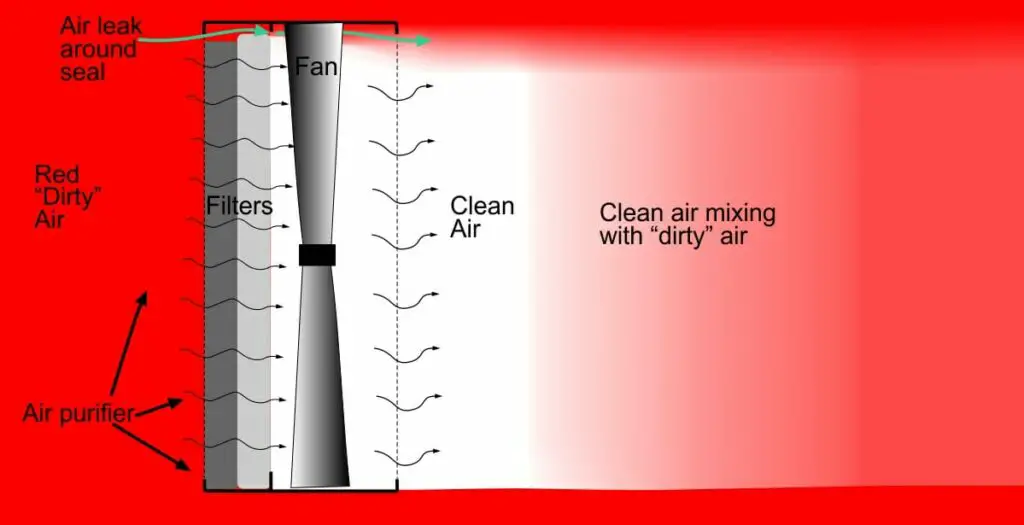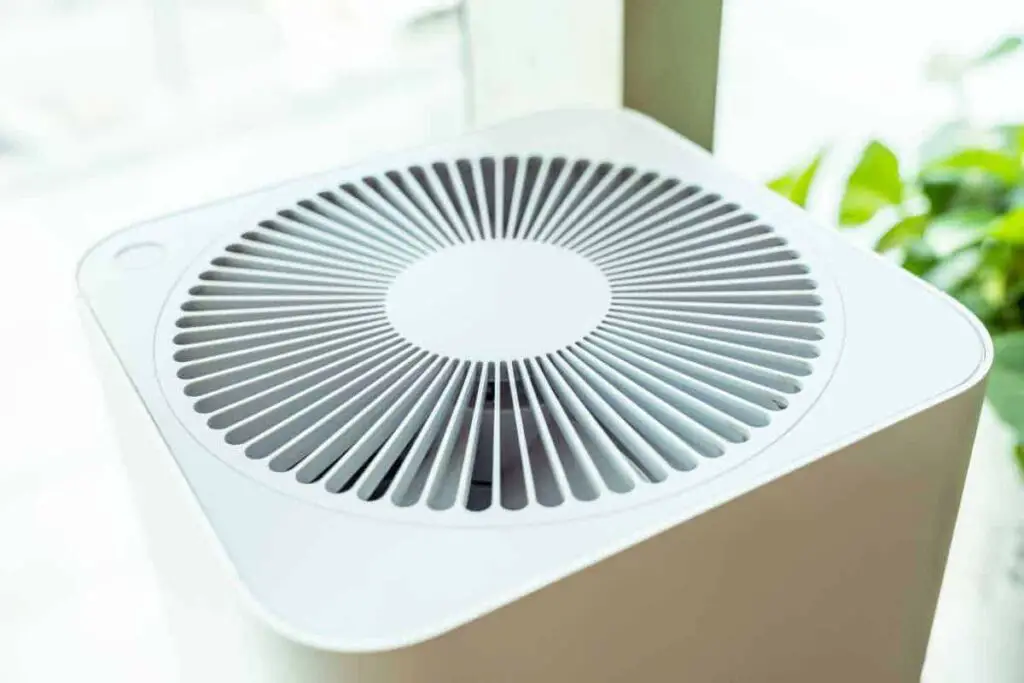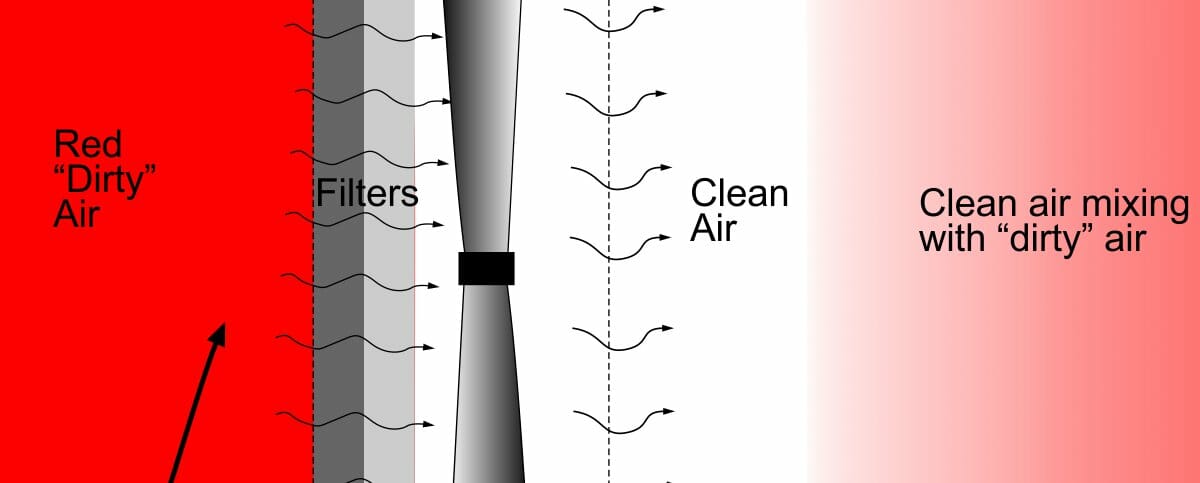If you are looking for an air purifier to improve your air quality, everyone knows they should buy one with a true HEPA filter. So it seems straightforward, but the term CADR keeps coming up. What is it and why does it matter?
On the whole, the CADR, the clean air delivery rate, is the most important single parameter that you need when buying an air purifier. It is the measure of the volume of air that can be purified per unit time. The CADR should be enough to purify 5 times the volume of the air in the room each hour.
This is the minimum standard that the EPA suggests you should be aiming for to improve your indoor air quality. Five air changes per hour should reduce the particle count by 80%.
We really need to stop thinking of air cleaners as only being necessary in the areas with most air pollution. The World Health Organization has now reduced the safe level for fine (PM 2.5) airborne particles to less than 5 mcg/m³. According to recent EPA statistics, 98% of people in the United States live with outdoor PM 2.5 levels greater than this. Also the level of air pollution in the home is often greater than the external air pollution because we produce air pollution in the home, for instance, by cooking. So arguably almost all US citizens should spend at least part of their day breathing filtered air.
So read on to find out more about this most important measurement.
How to Find the CADR Needed for Your Room
In general, you do not need to calculate precisely the CADR, providing the CADR is greater than the minimum needed for your room, it will be fine. Having a higher CADR just means that the air will be more purified than the EPA’s minimum specification. This can be seen in the following table from the EPA –

If you wish to calculate the CADR that you need for your room precisely, then you will a calculator–one can be found here. You also need a calculator if the room you will use the air purifier in has ceilings higher than 8 feet.
As the EPA’s minimum specification corresponds to an airborne particle count reduction of 80% you may wish to exceed the CADR in any case and have more purified air. The important point is that there is absolutely nothing to be lost by having a CADR higher than your room needs to meet minimum EPA standards. Your air will simply be better purified.
Here is an graph of particle reduction with time for an air purifier delivering 9.4 air changes per hour for a room. That is almost double the EPA’s specified minimum criteria of 4.9 air changes per hour –

So you can see that even with a tremendous CADR for the room size particle reduction was a relatively modest 85%.
Why does the particle count not drop to nearly zero over time? The reason is that there is a constant entry of particles into the room. Particles in the range of 0.3 micrometres are those that find it most easy to penetrate through the envelope of building through nanoscale openings around closed doors and windows or spaces around points where utility pipes and cables enter the home. This also applies to the flow of particles from one part of the home to another, under or around even a closed door and into the room. As particles are constantly entering the room, it is impossible to reduce the particle count 100%. There is an equilibrium reached where the number of particles removed by the air purifier from already fairly well purified air per unit time equals the number of particles entering the room per unit time.
CADR Calculations
How is the CADR Calculated?
As a general rule, to measure the CADR of an air purifier, it is placed in a sealed chamber 12′ x 10′ x 8′ high. Three test substances are used, smoke, dust and pollen. One of these is introduced into the chamber and a fan is used to thoroughly mix the test substance throughout the air in the chamber. Measurements are taken from one point in the center of the chamber. The number of airborne particles per unit volume are measured over time to measure the rate of decline of particle count due to natural deposition on surfaces.
After the chamber has been cleaned and is back in its normal state the experiment is repeated, this time with the air purifier on its maximum setting. The rate of decrease of particles in the air is then compared to that in the first part of the experiment. The difference between the increased rate of decline of particle number with time with the air purifier compared to just the decline with natural deposition allows the calculation of the CADR of the air purifier.
But anyone with an air quality meter can check the CADR of their air purifier as shown in this video-
You will need to get a copy of the Dylos table from their website.
Who measures the CADR?
In the United States air purifiers are tested according to AHAM’s (AHAM=Association of Home Appliance Manufacturers) AC-1 specification by accredited laboratories or the manufacturer. The air purifier then receives an AHAM Verifide certification. AHAM has been set up and is funded by the manufacturers of appliances.
CADR is Not Exactly the Same as Air Flow
The clean air delivery rate CADR, is not the same as the airflow through the air purifier. If all the air that went through the machine is perfectly cleaned then it would be. If 5% of the airflow escapes around the filter, because the seals are not good, rather than going through the filter then only 95% of the air has been cleaned and the CADR is –
CADR = 0.95 X airflow
This is illustrated in the image below-

The same applies to the filter. If there is a defect in the filter that some of the air can get through without being cleaned, this will mean that the CADR is lower than the airflow. HEPA filters are delicate and so can be damaged by rough handling in transit or defects can be present due to problems with manufacturing. This is one reason to only by an air purifier from a manufacturer you trust.
The Same Air Purifier Will Have Different CADR’s for Different Pollutants
Not all pollutants are removed equally by air filtration with a true HEPA filter. The smaller the particles easier it is for them to penetrate through the filter, so the more of them get through and so the lower the CADR is for the same airflow. So usually tobacco smoke particles penetrate the filter more easily and so the smoke CADR (small and very small particles) will be less than the pollen CADR (large particles), as the filter can easily stop the large pollen particles.
| Particle type | Particle size (um) | CADR (cfm) |
|---|---|---|
| Pollen | 0.5-11.0 | 240 |
| Dust (ISO Fine Dust) | 0.5-3.0 | 233 |
| Smoke | 0.09-1.0 | 230 |
Do not worry about this, As you can see it only makes a small difference to any calculations. Simply select the lowest quoted CADR rating this is usually that for smoke particles, when comparing air purifiers and sizing one for your room.
Air Purifier with the Best CADR
So naturally, you wish to buy the air purifier the best CADR as this will give you the best cleaning of your indoor air. However there are problems, the air purifier with the highest CADR is not the best air purifier for the following reason –
The Maximum CADR of an Air Purifier is Useless if You Cannot Use it Because the Air Purifier is Too Loud
The problem is that most of the peak airflows giving peak CADRs are simply too noisy to live with. So the consumer may buy an air purifier sized appropriately for his or her room based on the peak CADR and then not be able to live with the noise. Naturally, they will turn the air purifier down to the noise that they find acceptable, but the CADR at this air flow may be completely inadequate to purify the air in the room. The particle count then will be significantly higher than EPA would recommend as even the basic minimum reduction, and their health will deteriorate at a faster rate than it otherwise would have done.
This is of course a particular problem in bedrooms, where the air purifier needs to have a high CADR at a very low noise. I would highly recommend reading this article–”Best Air Purifier for a Bedroom“.
In the following graph, I illustrate this problem. I have 8 air purifiers from 5 different manufacturers and have several years experience of using air purifiers. Based on this experience, I think that the maximum tolerable noise from an air purifier for long-term use is 50 dB for an air purifier in a daytime room and 35 dB for one in a bedroom. So in the graph below, I have used 50 dB as the cutoff point for an air purifier being too loud. As you can see, 4 out of the 5 air purifiers would breach this threshold admittedly one not by much. This is a fairly typical selection of air purifiers and 4 out of 5 consumers would need to switch their air purifiers down. If they had brought them calculating that they were adequate for their rooms based on the maximum CADR, most would probably not return them, but just run them on a quieter setting, which unfortunately may not give them adequate air purification.
As you can see from the light blue line in the graph below, the difference between the peak airflow setting and the next setting down can be very large not only in terms of noise, but this is also reflected in CADR/airflow.

So any lack of data about CADR over the whole range of air flows for an air purifier will lead to one of the main problems with buying air purifiers. It becomes extremely difficult for the consumer to adequately choose and use an air purifier to lower the particle count in their air by the minimum the EPA regard as acceptable. Unfortunately, AHAM’s AC1 specification for testing air purifiers only stipulates testing them at maximum CADR, so leading to a lack of information.
Cute Manufacturer Room Size/CADR Trick to Watch Out For
Manufacturers can be funny, they think we will not notice. One of them really made me smile, they quoted with great pride the room coverage for the highest CADR/air flow for their air purifier and then the only gave noise data for the lowest CADR. So they were getting the consumer to buy the machine for their high CADR but not just not giving any noise data, they then gave noise data for the lowest CADR. So if the consumer did not read carefully when they got the machine home it would be more than 4 times noisier than they had expected!
If you really do not wish to deal with all these shenanigans, I would suggest just buying one of the recommendations from this website they have all been carefully vetted to weed out this and other sorts of “hidden” problems.
Not All Manufactures Specify the CADR of Their Machines at All!
It may seem strange, but not all manufactures give any CADRs for their machines at all. Some cite other approaches to estimating the adequacy of the air purification other than CADR, the approach used by the EPA and standard throughout the air purifier market. One manufacturer will give an airflow through the machine without the filter but not with the filter in! Obviously, this does not help the consumer as the airflow is bound to be much lower when the filter is in the machine, so the CADR will be much lower than the air flow without the filter.
In Addition to the CADR the Other Important Feature of an Air Purifier are the Filters
No amount of CADR will be of any use if the filters are not of high specification. Everyone knows that they should buy an air cleaner with a true HEPA air filter. However, people are often not aware that they should avoid filters labeled “HEPA like, HEPA style, 99% HEPA,”. True HEPA filters are superb at filtering out airborne particulate matter and will filter out 99.97% of particles 0.3 µm in diameter. They will easily deal with dust, allergen, house pet dander, dust mite, mold spores, and even remove most ultrafine particles.
The other filter that is needed is an activated carbon filter to remove volatile organic compounds and other chemical airborne pollutants.
The HEPA filter will gradually become blocked and to maintain the CADR/airflow, a replacement filter will be needed. In a similar way, once the activated carbon filter is saturated with chemicals and unable to take up more, it will need replacement.
Which Are the Air Purifiers With the Best CADR?
On the whole, the air purifier with best CADR is the Coway 400S. It has the highest CADR for the lowest noise of any air purifier 417 cubic feet per minute at a noise of 51db. This article explains this in more detail-“Best air purifier for a large room“.
What is a Good CADR?
On the whole, a good CADR is one that is large enough for your room. An even larger CADR will be better as the particle count will be lower. In magnitude, anything over 350 cubic feet per minute is excellent. The caveat is that the CADR will be useless if the air purifier makes so much noise in producing the you have to switch it down. So the air purifier must produce the CADR at less than about 50 dB.
How Correct and Useful Are CADR Ratings?
As a general rule, CADR ratings are accurate and absolutely essential in sizing the air purifier for your room. For further details please see this article–”How to use an air purifier“.
Conclusion
So as you can see, as a general rule, there are 3 crucial factors in choosing an air purifier, a true HEPA filter, the CADR, and the noise the air purifier makes.
It is simple enough to buy an air purifier with a true HEPA filter, but this alone is useless without an adequate CADR/airflow. So the CADR is really the central issue in choosing an air purifier. It has to be adequate for the size of room the air purifier will be used in. it will usually be limited to settings of the air purifier that are not maximal because air purifiers are almost invariably too noisy on their maximum setting.
As always, you must buy an air quality meter to check that you are achieving the minimum recommend 80% reduction in airborne particle count. I know this sounds tough, but it really is the only way of making sure that you are achieving an air quality which will protect your health. Air quality meters can be cheap, as little as $25-“How to Test Air Quality in Your Home“.
Related Questions
Related Posts

How does an air sterilizer work?


